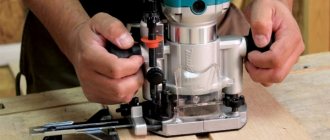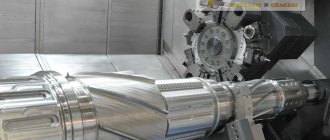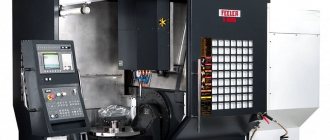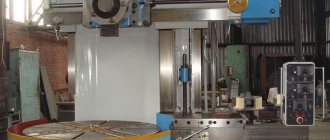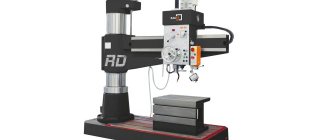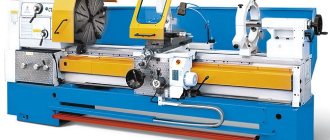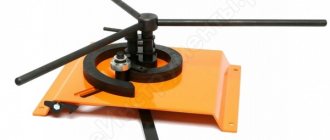Advantages of Soviet-made devices
Soviet machines are distinguished by their reliability and versatility. All milling machines are divided into the following types:
- special;
- frontal, screw-cutting;
- carousel;
- revolver;
- cutting;
- semi-automatic and automatic with several spindles;
- ordinary specialized machines.
Most components in Soviet equipment are easy to replace, which increases the operational capabilities of the equipment.
Old Soviet models of wood and metal machines
Soviet equipment is still in use in production. Some people fundamentally prefer to equip their home workshops with units from the USSR.
Important!
It is sometimes difficult to find equipment or components for Soviet equipment in case of breakdown.
Screw-cutting lathe IT-1M
The lightweight machine was intended for gaining practice in workshops. Allows you to process cylindrical workpieces from the outside, drill and boring, and cut threads. Currently out of production.
The most reliable and best models for metal and wood processing
Of the variety of Soviet equipment, there are several models that are considered the best and have been used for many decades, including in modern production.
Vertical milling 6P12
This machine is widely used in the engineering industry. Used in medium-scale production and when processing small workpieces. The main advantage of this equipment is its simplicity and reliability. This equipment can be used to process workpieces made of steel, cast iron, as well as difficult-to-cut metals.
At the moment, the Gorky plant no longer produces these machines, but they are popular and are still used in production. The equipment allows you to work with rounded and uneven surfaces.
NGF 110 Ш4
This is a tabletop machine that is still used as special school equipment to this day. Designed for milling work on horizontal surfaces, grooves, and other planes. The equipment uses disk, end and face mills, as well as shaped cutters. The cutters are mounted on the mandrel using mounting rings and a nut.
This is a highly versatile machine with a high class of accuracy for processing parts. Equipped with horizontal and vertical spindles, it is capable of performing a range of milling and boring operations. The presence of two spindles, one of which is rotary, makes the device indispensable in the field of mechanical engineering, in the production of tools, relief stamps and other devices. The machine is used in single and small-scale production and is used in tool and mechanical shops of machine-building enterprises.
OF 55
Another option for highly versatile milling equipment with a higher accuracy class. The machine is equipped with two mechanical feeds and one additional manual feed. has two spindles in its design: vertical and horizontal. Rotating vertical spindle, can be rotated at any angle.
This equipment can be used to perform: drilling, reaming, chiselling, centering, countersinking, reaming. The main advantage of the machine is a wide range of spindle speeds and feeds. This enables cost-effective processing of a wide variety of parts in energy-efficient modes.
Vertical milling 6T13
This is a cantilever vertical milling machine, produced by the Gorky Milling Machine Plant and is still considered one of the best units for processing vertical and horizontal planes, grooves, corners, frames, and gears. The machine has 3 operating modes: automatic, manual and jog.
Rectangular guides of the frame and console give the equipment additional rigidity. It is possible to expand the technical parameters of the machine through modernization. A big plus is the mechanized fastening of the tool.
Vertical milling 6Р13
Another model produced by the Gorky Milling Machine Plant. Equipped with a vertical quill spindle. The table moves crosswise in a horizontal plane. Designed for processing parts made of steel, cast iron, hard-working surfaces, as well as non-ferrous metals. Processes vertical, horizontal and inclined planes, corners, grooves, frames and various curved surfaces. It is successfully used for processing cabinet workpieces of various shapes and sizes.
Horizontal milling 6Р82
The horizontal cantilever milling machine performs high-precision work on a variety of types of metal. Despite the fact that the equipment is over 40 years old, the machine is still considered one of the most affordable and reliable units for various branches of mechanical engineering. The role of the console is performed by special brackets. The spindle in this unit always remains in the same position. The work table itself can be installed at right angles to the spindle.
Horizontal milling 6T82G
The horizontal high-speed milling machine is designed for milling various parts made of steel, cast iron, and non-ferrous metals. The unit can be configured for various automatic and semi-automatic operating cycles. This is original equipment with increased precision and rigidity parameters.
Widely versatile milling machine made in Vilnius. Equipped with a vertical rotary spindle and is perfect for small-scale and individual production. The capabilities of the unit allow the use of high-speed steel tools. Desktop size 200x800 mm.
NG110-Sh4
This model is produced by the Rostov plant of small-sized machine tools. Processing is carried out using end, end and shaped types of arrows. The machine itself is intended for equipping school workshops and small workshops.
Metal milling machines
Metal milling machines are presented on our website in a wide range, which will allow you to select and buy the equipment that is most optimal in price and functionally suitable for solving the tasks assigned to your production, or for changing equipment, the operation of which at your enterprise becomes impractical due to moral or physical wear.
Milling machines are a group of metal-cutting and woodworking machines classified by type of processing. Milling machines are designed for processing, using a milling cutter, flat and shaped surfaces, gears, etc., metal and other workpieces. In this case, the cutter fixed in the spindle of the milling machine makes a rotational (main) movement, and the workpiece fixed on the table makes a linear or curved feed movement (sometimes carried out simultaneously by a rotating tool). Control can be manual, automated or carried out using a CNC system.
In milling machines, the main motion is the rotation of the cutter, and the feed motion is the relative movement of the workpiece and the cutter.
Auxiliary movements are necessary in the machine to prepare the cutting process. Auxiliary movements include movements associated with setting up and adjusting the machine, its control, securing and releasing the part and tool, bringing the tool to the surfaces being processed and removing it; movements of devices for automatic control of dimensions, etc. Auxiliary movements can be performed on machines either automatically or manually. On automatic machines, all auxiliary movements in a certain sequence are performed automatically.
Types of milling machines
- universal (with rotary table);
- horizontal milling console (with a horizontal spindle and console);
- wide-universal (with additional milling heads);
- widely-universal tool tools (with a vertical working plane of the main table and transverse movement of spindle units);
- vertical milling machines (with a vertical spindle), including cantilever ones;
- non-console (also called cross table);
- with a mobile portal;
- copy-milling;
- continuous milling machines, including rotary milling machines;
- drum-milling.
Universal milling machine
It has a horizontally located spindle and is designed for milling various surfaces on small and light parts in single and mass production. Processing is carried out with cylindrical, disk, angular, end, shaped, and end mills. This machine can process vertical and horizontal shaped and screw surfaces, grooves and corners. Milling of parts requiring periodic division or screw movement is performed using special dividing devices.
All the main components of the machine are mounted on the bed. The spindle assembly and gearbox are located inside the frame. To support the mandrel with the cutter, there is a trunk with earrings (pendants). The console carrying the feed box moves along the vertical guides of the frame. Along the console guides, a sled with a rotating device moves transversely, which carries a longitudinal table and allows the table to be rotated around a vertical axis by 45° in both directions, so that the table can move in a horizontal plane at different angles to the spindle axis. Torque from the engine is transmitted through a gearbox to the spindle - a hollow shaft in the upper part of the frame. A mandrel is inserted into the front end of the spindle and secured with a dowel - a rod fixed in the spindle. A mandrel is usually a rod that has a conical seat—a Morse cone—that receives rotation from the spindle; The cutter and rings securing it are put on the mandrel and clamped with a nut. The rigidity of the mandrel is maintained by the suspension.
Horizontal milling machine
Horizontal milling machine (1 - foundation plate, 2 - bed, 3 - console, 4 - slide, 5 - table, 6 - trunk, 7 - mandrel with cutter)
It differs from a universal milling machine in the absence of a rotating device, that is, the machine table can only move perpendicularly or together with the slide parallel to the spindle axis.
Widely versatile milling machine
Unlike a horizontal milling machine, it has another spindle head mounted on a retractable trunk, which can be rotated at any angle in two mutually perpendicular planes. Separate and simultaneous operation of both spindles is possible. For greater versatility of the machine, an overhead milling head is mounted on the rotating head, which allows the machine to process parts of complex shapes not only by milling, but also by drilling, countersinking, boring, etc.
Some machines of this type do not have a console, and instead a carriage moves along the vertical guides of the frame. The carriage has horizontal guides for a slide with a vertical working surface and T-shaped slots on which a table, indexing and other devices are mounted. The wide versatility of the machine allows it to be used in experimental and tool shops for the production of jigs, clamping devices of all types, tools, dies, molds and other parts.
Vertical cantilever milling machine
Vertical milling machine (1 - cutter, 2 - spindle, 3 - trunk, 4 - bed, 5 - table, 6 - slide, 7 - console, 8 - base plate)
Unlike horizontal milling, it has a vertically located spindle, which in some machine models allows displacement along its axis and rotation around a horizontal axis, thereby expanding the technological capabilities of the machine. Unlike horizontal milling machines, the arbor for vertical machines is a flange with a Soviet-standard Morse taper or a more modern ISO-40 taper on one side and a corresponding tapered hole on the other, where the end mill is inserted. If it is necessary to install a disk cutter, a mandrel is used as on a horizontal milling machine, but much shorter; Likewise, on horizontal machines, it is possible that mandrels on vertical machines are used to attach end mills. Vertical feed movement, as a rule, can also be carried out with a tool.
Vertical and horizontal milling machines without console
Designed for processing vertical, horizontal, inclined surfaces, grooves in large parts. Unlike cantilever milling machines, these machines do not have a console, and the slide and table move along the guides of the frame mounted on the foundation. This design of the machine ensures higher rigidity and processing accuracy compared to cantilever-type machines, and allows processing parts of large mass and size. The spindle head, which is also a gearbox, has an installation movement along the vertical guides of the rack. In addition, the spindle together with the sleeve can be moved in the axial direction when accurately setting the cutter to the required size.
Longitudinal milling machines
Used for processing large-sized parts, mainly with end processing; as well as cylindrical, end, disk and shaped cutters. The machines are divided into single-column and double-column. In a four-spindle, two-column longitudinal milling machine, the bed has a table and a portal consisting of two posts and a beam. A traverse and two horizontal rotary milling heads move along the guides of the racks. The other two milling heads move along the traverse guides. Parts can be processed with a moving table and stationary milling heads, with a stationary table and feeding heads, or with a simultaneously moving table and milling heads.
In our company you can buy new metal milling machines at competitive prices from domestic and foreign manufacturers. Our sales specialists will be able to select the most suitable option for you.
Where can I buy equipment from those times?
Most of the models described are currently no longer in production. But it is quite possible to purchase them. A huge number of online stores offer modernized and improved Soviet-made machines for sale. It is enough to familiarize yourself with the catalog to choose the right model.
The seller delivers and, if necessary, advises on upgrading the equipment. The main advantage of Soviet equipment is that it can be easily improved, and all main components can be easily replaced, which significantly extends the service life of the machine.
Soviet-made machines are distinguished by reliability and quality of processing, as well as versatility. Most models can be further improved and their functionality expanded. That is why almost all Soviet machines are still used in mechanical engineering and metalworking production.
Lathes in the USSR: which ones were used during the Union?
USSR lathes are still used in enterprises. New equipment is almost impossible to find. But the old one has retained all its characteristics; it is enough to replace some components to get the result.
Since the 18th century, special machines began to be used instead of manual labor. At first the designs were steam-powered, then they switched to using electric energy; there was no exception for USSR lathes. They have become one of the most important inventions that make modern life easier.
USSR lathe
During the Five-Year Plans, during the Great Patriotic War and after it, the Soviet Union actively used various machines to boost the country's economy. In the USSR, lathes for metal and wood were most often used to create weapons, military equipment, as well as other devices and devices that would help in difficult times.
During the war, people actively worked on machines. The lathes of the USSR are well preserved, there are no photos left from those times, but the machines have survived to this day. And when you come to the museum of military equipment, most likely you will see devices from factories there. The machines were made well and with high quality, so that they would not wear out and would last for a very long time, and so it turned out.
Scope of application of lathes
The purpose of creating equipment is to process various parts on a metal and wooden base. To do this, various operations are performed:
Turning cutters boast the widest functionality if you have the necessary tools and equipment:
- Drilling.
- Trimming, end processing.
- Thread cutting.
- Internal surface treatment.
- Turning grooves, cones and other similar shapes.
- Boring, turning surfaces in the form of cones, cylinders, smooth shaped type.
The machines can be used in both large-scale and small-scale production. Each owner chooses the option that suits him. The choice of models was wide from the very beginning.
Types and types of Soviet lathes
The classification, developed while the Soviet Union was in force, is still used to this day. The following types of metal-cutting equipment are basic:
- Special.
- Automatic, conventional machines for specialized purposes.
- With several cutters for polishing.
- Frontal, screw-cut.
- Carousel variety.
- Cutting group.
- Revolving.
- Semi-automatic, automatic with several spindles.
- Automatic and semi-automatic with one spindle for metal.
Design of a lathe and photos of its individual parts
The design of this type of equipment always contains the following components:
- Electrical part. We are talking about electric drive motors. Power varies from model to model. The group also includes elements responsible for controlling certain parts of the machine. The main thing is that these parts meet safety requirements.
- Gearbox. In the presence of such a structural element, the machine support receives the energy of movement. Lead screws and rollers act as sources of this energy.
- Caliper. Fastens the cutting elements of the structure. Provides transverse and longitudinal feeding of devices. The design is necessarily complemented by the so-called bottom carriage, or several. Holders for turning tools are fixed on other carriages, at the top.
- The spindle head contains the spindle itself. In the inner part there is a gearbox. Woodworking machines are also not devoid of this part.
- Apron. Helps ensure that the movement of the roller is converted into movement of the caliper. The lead screw can also participate in this process.
- Bed. Refers to the load-bearing elements of turning units. Other elements of the machine are mounted on it.
The rest of the elements are supported by two special cabinets included in the set. They have a load-bearing function for equipment. Thanks to this part, the operator is able to select the maximum workpiece height that is most convenient. The cabinets are known for their massive construction.
Lathe design
The main nodes are:
- The bed is a supporting structure on which all components are located.
- Headstock - it contains the spindle, which rotates with the part, and the gearbox.
- Tailstock - additionally secures the part during processing in the centers. The quill is used to attach a cutting tool (drill, reamer).
- Caliper - carries a tool holder into which turning tools are attached. Moves in the transverse and longitudinal direction at a given speed.
- Feed box - provides movement from the lead screw or shaft to the caliper.
Important! On most models, the main components are unified.
Brief description of the most common models of Soviet lathes
A wide range of functions have been included with the machines from the very first release. It is enough to look at the most popular brands to be convinced of this.
School lathe TV-4
Created to teach the basics of turning to students and schoolchildren of all ages. Provides access to a large number of work operations, including:
- Multi-start thread.
- Threads of different shapes, pitches: outside and inside, inch, trapezoidal, persistent.
- Boring work for surfaces in the shape of cones and cylinders.
- Carrying out countersinking.
- Boring holes.
- Reaming.
The workpieces rotate inside the centers and chucks - this is the main movement characteristic of the workpieces. The spindle receives energy from the gearboxes. The serve itself is a secondary factor, as is its movement. Thanks to this, even the old cutting tool and the workpiece are brought together.
Capable of processing parts with a diameter from 125 to 200 mm.
0.6 kW - the installation is equipped with electric motors with this average power.
Metal lathe Shkolnik TV-7
Equipment for educational purposes. Designed for training to perform the following operations:
- Countersinking.
- Deployment.
- Processing with a drill.
- Metric thread cutting.
- End processing with different parameters.
- Turning, boring parts.
The belt moves to another pulley pair if the speed is reduced. The main regulator is the handle on the right stand of the device. The result is support for up to four speeds.
Two pairs of gears are located inside the gearbox. The handle allows you to manually adjust the unit. Switching the clutch increases the number of available driving speeds to 8 units. The headstock is not supplemented with handles that simplify the adjustment of the required rotational numbers of the spindle.
The electrical circuit components are located in the right cabinet. The support with the tailstock is placed on the frame guides. Additionally, there are protective elements to prevent operators from being damaged by chips.
The dimensions of the workpiece range from 100 to 300 mm.
School metal lathe TV6
Using this type of equipment, operators gain access to the following operations:
- The workpiece is partially cut off.
- Conical and cylindrical surfaces are bored and machined.
- Metric thread.
- End adjustment.
- Drilling holes.
The machine is distinguished by its original characteristics, which do not allow processing of steel with a hardened surface. The device has the following parameters:
- 350mm distance between centres.
- The spindle maintains 130-170 rpm when rotating.
- 108 mm - at this height there are parts in the center.
- 300 millimeters is the length of the surface to be turned.
- 12 millimeters is the maximum diameter for the workpiece being processed.
The 300-kilogram weight distinguishes the machine, even if the equipment is minimal.
Tabletop metal lathe TV-16
Equipment processing metal parts is characterized by small dimensions. To perform basic operations included in turning operations:
- Making holes.
- Thread with different characteristics.
- Average complexity of operations.
- Carrying out boring and turning.
160 mm is the maximum limit for the size of workpieces in processing if they are above the bed. 90 millimeters is the same size for the location above the caliper. 250 mm – maximum length limit in the central part. The through spindle hole has an increased width when compared with the TV-4 model - it will be 18 mm.
The frame is cast, made of cast iron. It is complemented by three longitudinal grooves that serve as guides. Standard power indicators are in the range of 0.4-0.5 kW. 1400 rpm is an indicator for the rotation speed, which determines how efficient the milling machine will be.
If you choose the spacers correctly, you can avoid the appearance of various gaps. The belt tension of the V-belt drive must be correct, otherwise the result will not be achieved.
Cantilever milling machines produced in the USSR and CIS
| Series | Size | Manufacturer | Year | Model |
| 6 | 2 | SFFS | 1932 | 682 |
| 6B | 0 | |||
| 1 | ||||
| 2 | SFFS | 1937 | 6B12, 6B82, 6B82G | |
| 3 | ||||
| 6K | 0 | |||
| 1 | DZFS | 6K11, 6K81, 6K81G, 6K81SH | ||
| 2 | SFFS | 6K12, 6K82, 6K82G, 6K82SH | ||
| 3 | SFFS | 6K13P, 6K83, 6K83G, 6K83SH | ||
| 6H | 0 | Zalgiris | 1969 | 6N10, 6N80, 6N80G, 6N80Sh |
| 1 | DZFS | 1970 | 6N11, 6N81, 6N81G, 6N81A, 6N81D | |
| 2 | SFFS | 1951 | 6N12, 6N82, 6N82G | |
| 3 | GZFS, VSW | 1951 | 6N13, 6N13F3, 6N83, 6N83G, 6N13GA | |
| 6M | 0 | Zalgiris | 6M10, 6M80, 6M80G, 6M80Sh | |
| 1 | DZFS | 1971 | 6M11, 6M11K, 6M81, 6M81G, 6M81Sh, 6M81Sh-1, 6M81Sh-1F1, 6M81ShF2 | |
| 2 | SFFS | 1961 | 6M12P, 6M12PB, 6M82, 6M82G, 6M82GB, 6M82Sh | |
| 3 | SFFS | 1961 | 6M13P, 6M13PB, 6M83, 6M83G, 6M83Sh | |
| 6Р | 0 | Zalgiris | 1973 | 6Р10, 6Р80, 6Р80Г, 6Р80Ш |
| 1 | DZFS | 6Р11, 6Р11К, 6Р11Ф3, 6Р81, 6Р81Г, 6Р81Ш | ||
| 2 | SFFS | 1972 | 6Р12, 6Р12К, 6Р82, 6Р82Г, 6Р82Ш | |
| 3 | GZFS, VSW | 1972 | 6Р13, 6Р13Б, 6Р13Ф3, 6Р13Ф3-3, 6Р83, 6Р83Г, 6Р83Ш | |
| 6T | 0 | Zalgiris | 1986 | 6Т10, 6Т80, 6Т80Ш |
| 1 | ||||
| 2 | SFFS | 1985 | 6T12, 6T82, 6T82G, 6T82Sh | |
| 3 | SFFS | 1985 | 6Т13, 6Т83, 6Т83Г, 6Т83Ш | |
| 6D | 0 | DZFS | 1987 | 6D10, 6DM80Sh |
| 1 | DZFS | 1990 | 6D81, 6D81, 6D81G, 6D81SH | |
| 2 | DZFS | 6D12, 6D12F20, 6D12F3, 6D82, 6D82G, 6D82SH | ||
| 3 | DZFS | 6DM83SH |
The main manufacturers of milling machines in the USSR and Russia:
VSW - Votkinsk Machine-Building Plant. Currently - Votkinsk Plant, JSC
GZFS - Gorky Milling Machine Plant. Currently - ZFS Milling Machines Plant, LLC
DZFS - Dmitrov Milling Machine Plant. Currently - Dmitrov milling machine plant DZFS, LLC
UZTS - Ulyanovsk plant of heavy and unique machine tools UZTS. Currently - Ulyanovsk Plant of Heavy and Unique Machine Tools UZTS, LLC
VSZ - Voronezh Machine Tool Plant.
Zalgiris – Vilnius Machine Tool Plant
Safety rules when working on a lathe
The provisions of the safety rules are as follows:
- Compliance with the original technical specifications is mandatory when performing work. To do this, first obtain a drawing from the master. Or another type of description of the technological process associated with processing.
- Before starting work, be sure to conduct a technical inspection. This is necessary in order to detect and eliminate individual technical faults in a timely manner. If necessary, call a technician.
- Special clothes are fastened with all buttons.
Work cannot be started if any equipment adjustment or other types of maintenance are being carried out. Do not use machines whose centers are heavily worn. The same applies to any tools or clamping materials - you should discard them at the slightest sign of malfunction.
If the breakdown is related to the electrical part, the technicians are prohibited from fixing it themselves.
Safety regulations
Turning and milling machining centers for metal
When working even on the simplest school unit of a turning group, it is necessary to strictly observe the safety requirements, which are as follows.
- All operator clothing must be fastened with all buttons.
- Before starting work, it is necessary to perform a technical inspection of the device, during which individual malfunctions in its operation may be identified. If such malfunctions are detected, if the operator cannot quickly eliminate them with his own hands, it is necessary to call a technician (or an adjuster) who will deal with this issue.
- All technological operations on a lathe should be carried out only in accordance with the technical specifications, for which you must first obtain a drawing or a detailed technological processing process from the master.
Safety Reminder when working on lathes (click to enlarge)
The operator of a machine, including one equipped with a CNC system, is strictly prohibited from:
- start work if the device is currently being adjusted or serviced;
- work on the machine if its centers have undergone significant wear;
- use tools and clamping elements during processing that show even the slightest signs of malfunction;
- independently troubleshoot problems related to the electrical system of the equipment;
- move away from the machine, which is turned on, and also entrust its control to unauthorized persons.
Woodworking machines USSR model
Contact Name:
Vasya
Working machine! Requires lubrication and painting! The jointing machine SSF6-1 is designed for straight one-sided planing of products from various types of wood along a plane and at an angle.
The design of the machine, thanks to the monoblock spindle assembly and cast iron bed and tables, has significantly reduced the level of vibration and increased the cleanliness of processing. Thanks to this, the machine allows you to obtain a geometrically accurate base plane for subsequent processing on a thickness planer or four-sided planer.

